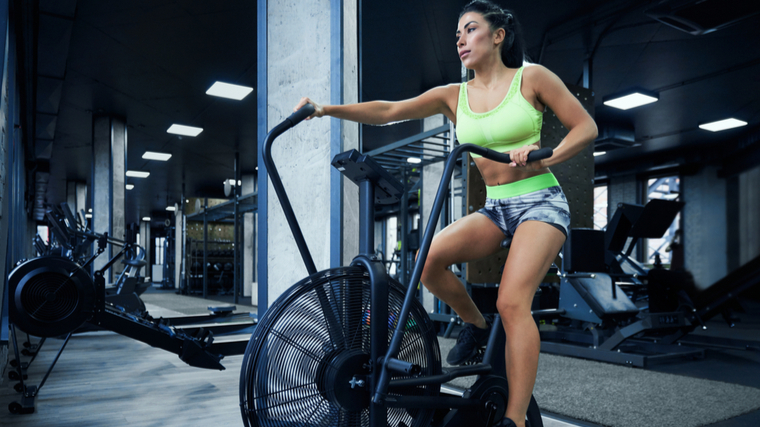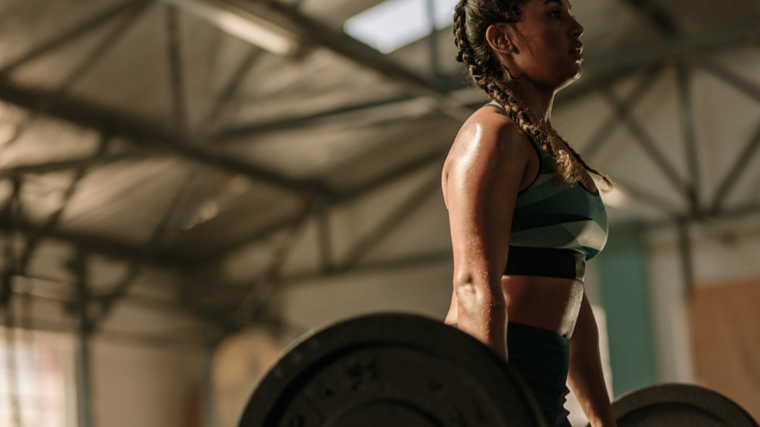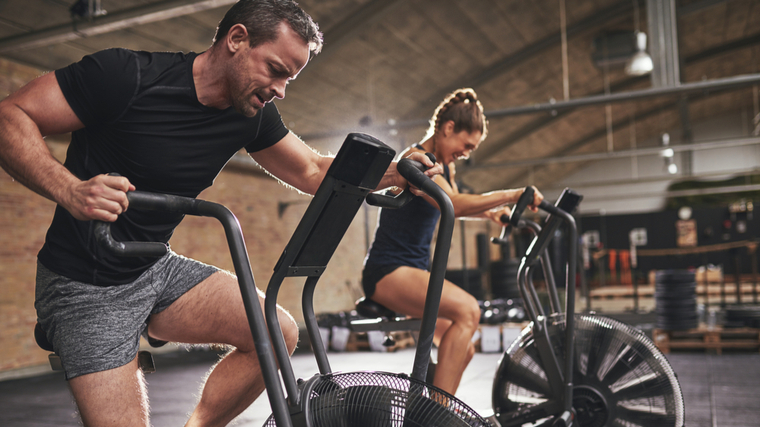With the constantly rising popularity of smart watches, it seems like everyone is looking for the next best way to burn calories and stay in shape. However, doing the same thing over and over again because you know it’ll burn those calories can get boring and might cause you to lose motivation.
In the same way that you’d modify your weight lifting routine to keep your training fun and fulfilling, you shouldn’t be afraid to dabble in different disciplines of cardio. You can burn heaps of calories without ever stepping onto a treadmill.

Whether you’re short on time or have limited gym equipment, there are plenty of different ways to burn 100 calories. Below you’ll find a slew of different options for getting your heart rate up and breaking a nice sweat.
How to Burn 100 Calories
- Run a Mile
- Take a Walk
- Go For a Swim
- Grab a Jump Rope
- Lift Weights
- Take the Stairs
- Try HIIT
- Hop on a Bike
- Do a Little Dance
- Do Yoga
What Are Calories?
It doesn’t matter if you’re sitting, standing, walking, or sleeping, you’re constantly burning calories. Physical activity not only burns calories while you’re moving, but even occurs long afterward during what is known as excess post-exercise oxygen consumption (EPOC).
A calorie is a unit of energy. Kilocalories or “big” calories are what are most commonly known as the calories in food. Although calories may be a scary word for some who are trying to count them to lose weight, your body needs calories to supply energy for physical activity and everyday life.
Consuming too many calories regularly can cause obesity, heart disease, diabetes, high blood pressure, and more, but consuming too little can result in insufficient nutrients and energy, as well as cause psychological stress. It’s important to know that not only the quantity but the quality of calories make an impact. Studies suggest that consuming calories from fruits, vegetables, and whole grains can help reduce risks of diseases like cancer. (1)
How to Burn Calories
The amount of calories you burn are dependent upon a couple of things. The first being your resting energy expenditure (REE), which is the energy requirements of the body at rest. This is determined by lean body mass and accounts for approximately 60-70% of energy expenditure. Physical activity is also a determining factor in how many calories you burn daily because your body uses more energy during exercise, which burns more calories. (2)
After physical activity, you may experience EPOC, which is the elevation of your REE as your body works to restore muscle glycogen and rebuild muscle proteins that may have been damaged during exercise. (3)
Generally speaking, higher-intensity activities burn more calories than less intense activities. Studies suggest that vigorous activity can be classified as using 60-84% of aerobic capacity, also known as V02 max, whereas moderate intensity uses 40-59%. (4)
Although heart rate is not the sole factor in determining caloric burn, it can help. You can use a smartwatch to track your heart rate and calories or simply use your heart rate to estimate the calories burned. Ultimately, the amount of calories you burn is not a one-size fits all. Your weight, gender, and body composition can all affect it.
Different Ways to Burn 100 Calories
Knowing what calories are and how they’re burned can help you determine the best ways for you to shed some fat quickly and easily. Below are just some of the different ways.
Run a Mile
Give or take. A popular thought is that running one mile equals about 100 calories, but again, this isn’t totally accurate, and it does depend upon your body specifically. Running has a couple advantages over other gym activities, one being it can be done anywhere. You can use the treadmill at the gym or run around the block and reap pretty similar benefits.
Depending on the intensity of your run, it can be considered a more vigorous form of exercise, which may burn more calories than moderate intensity exercise. Research shows that the energy used while running is about double compared to moderate intensity walking. (5) So if you’re looking to burn more calories in a shorter amount of time, choose to run.
Not only does it have the potential to burn 100+ calories, but studies suggest that running even just 10 minutes a day, which can be considered an average mile time, can help reduce the risk of cardiovascular diseases and all-cause mortality. (6)
Take a Walk
Walking is one of the most accessible forms of exercise there is, and it can be considered lower impact than running. Taking a daily walk around the block is a beneficial way to burn calories and help improve your overall health. Studies show that walking can be just as accepted as running for exercise since they both raise energy expenditure above resting level. (7)
Just because you may not be running marathons or five-minute miles doesn’t mean you’re not burning calories or potentially contributing to weight loss while walking. More than just a handful of benefits can come from walking, including improved heart health, digestion, immune system, creativity, and mental relaxation.

Although running may seem like the favorable choice when looking to burn calories, you can still choose to walk for longer distances or at varying speeds. In fact, studies suggest that just the act of changing your speed while walking may account for 4-8% of your daily walking energy. (8)
Go For a Swim
Water-based aerobics and swimming are especially popular in the senior or rehabilitation community due to its ability to help increase strength and burn calories in one of the lowest impact of ways. Research shows that implementing swimming regularly into your routine can help decrease body fat and help improve flexibility and cardiovascular endurance. (9)
Since swimming has the ability to use most, if not all, of your major muscle groups, it can be a quick way to get your heart rate up. Similar to running, the more vigorous the pacing, the more calories you can burn, but studies suggest that on average, swimming can burn around 500 calories per hour. (10)
By this theory, swimming for just between 10-15 minutes can help you burn around 100 calories. Swimming in open water versus a pool will likely produce different intensities, but either way, this activity is a surefire way to burn a good amount of calories in a short amount of time.
Grab a Jump Rope
Jumping rope can get your heart rate up, but studies suggest it can also help improve balance and coordination. (11) It’s another easily-accessible activity that can be done anywhere and with different styles.
The most common style is single-unders, meaning the rope crosses under your feet once as you jump. But you can also perform double-unders, backwards jumping, criss-cross, and so many more to keep your workout interesting and challenging. Whichever style you choose, you’re guaranteed to burn a good amount of calories.
Jumping rope can be considered a form of plyometrics and can help you burn 100 calories fairly quickly. Research shows that jumping rope for just 10 minutes at a vigorous intensity can increase heart rate and energy expenditure, which can increase your cardiorespiratory fitness. (12)
Lift Weights
Although cardio is more commonly associated with increasing your heart rate, lifting weights has the potential to do so as well, while also increasing your EPOC. Studies suggest that resistance training can produce the same level of EPOC as high intensity interval training. (13)
You may find that you can burn more calories in real time by performing cardio exercises, so you may need to spend 25-30 minutes lifting weights to get to 100 calories. However, the potentially greater afterburn you can get from resistance training makes it worthwhile.

Lifting weights can help you burn calories during and post-workout, and it can also provide benefits to your overall health, including improved bone health, increased muscle mass and strength, reduced joint pain, and better mental health. (14)
Take the Stairs
If you work on the top floor of a building, you may have a tendency to take the elevator because it’s faster and easier. What you may not realize is deciding to take the stairs can aid in weight loss, improve blood pressure, and help increase lower body strength. (15) One flight of stairs probably won’t burn 100 calories, but walking up and down a flight of stairs for just 10 minutes might.
If you don’t have easy access to stairs, you can also try the stair climber at the gym. You may be used to hopping on the treadmill, but studies suggest that using stairs compared to walking can help increase your V02 max. (16) The higher your V02 max, the more energy you can expend, resulting in a higher calorie burn.
Try HIIT
High intensity interval training, or HIIT, is a popular style of exercise because of its ability to accomplish more work in less time. The idea is to alternate between high intensity exercise and short recovery periods. Styles like the AMRAP or Tabata can be great for burning 100 calories quickly.
Studies suggest that HIIT can burn 25-30% more calories in 30 minutes compared to resistance training, cycling, and using the treadmill. (17) Along with a greater calorie burn, HIIT can aid in body fat loss (18) and can reduce blood pressure more than lower-intensity exercise. (19)
Depending on the workout, HIIT can be accessible as just bodyweight exercises like burpees are a great way to get your heart rate up. Just 10 minutes of high intensity interval training can help you burn 100 calories right then, and it can increase EPOC to keep you burning more calories even at rest.
Hop On a Bike
Whether you’re taking a spin class or riding a bike down a nearby trail, cycling can help you burn calories while improving your overall health. Studies suggest that cycling can help improve aerobic capacity and aid in blood pressure and weight reduction without losing muscle mass. (20)
The more muscle you have on your body, the more calories you can burn just at rest, so performing activities that help maintain muscle is essential. The more intense you bike, meaning either a faster pace or added inclines, the faster you can burn 100 calories, but even at a moderate pace, you can burn 100 calories in 30 minutes or less.

Cycling can be appealing to individuals of different ages and fitness levels due to it being low impact, so if running is tough on your joints, you can try a bike instead.
Do a Little Dance
Dancing can be a fun activity to do on the weekends to relax and blow off steam, but it also has the potential to help you burn 100 calories in less than 30 minutes. Zumba is a popular style of dance that is categorized as an exercise class and can be offered in many commercial gyms. Studies suggest that Zumba can burn approximately six to seven calories per minute depending on the individual and the dance. (21)
By this theory, dancing for just 15 minutes a day could help you reach your daily 100 calorie goal. The beauty of an exercise program like Zumba is it combines fun, light-heartedness with a promotion of better overall health. It’s easily accessible even if you don’t have a gym membership because there are plenty of YouTube videos that break down the dances for you.
Do Yoga
Many people may understand the benefits of resistance training and aerobic activity, but flexibility and range of motion are extremely important to be able to perform regular activities in and outside the gym. Yoga can help improve flexibility while increasing strength, and it can help you burn at least 100 calories.
Although yoga is often seen as a “less intense” style of exercise, challenging poses and active movements can burn those calories. According to a Harvard study, doing yoga for just 30 minutes can help you burn over 100 calories. (22)
It can depend strongly on the type and level of class you’re in. Hot yoga has the potential to burn more calories than a conventional type, and Vinyasa Flow requires constant movement, which can get your heart rate up.
Wrapping Up
It’s important to understand that having a calorie intake goal is just as important as having a calorie burn goal. Not fueling your body enough with the proper nutrition can result in lower energy levels and can even cause you to gain weight. Often when trying to lose weight, people focus on a calorie deficit and completely disregard their basal metabolic rate. Counting your macros is a good way to stay on track while fueling your body with the right foods.
Staying active and having a calorie burn goal can be beneficial for your physical and mental health as long as you do it the right way. There are plenty of different ways to burn 100 calories daily that are easily accessible and maybe even fun to do. Exercise looks different for everyone, and finding something that makes you happy and keeps you motivated is crucial for long-term success. If you don’t like running, then bike. If you don’t have a bike, then dance. Find what works best for you and burn those calories.
References
- Osilla, Eva V., Safadi, Anthony O., Sharma, Sandeep. Calories. StatPearls. 2021.
- Howell, Scott, Kones, Richard. “Calories in, calories out” and macronutrient intake: the hope, hype, and science of calories. American Journal of Physiology. 2017. https://doi.org/10.1152/ajpendo.00156.2017
- Børsheim, Elisabet, Bahr, Roald. Effect of exercise intensity, duration and mode on post-exercise oxygen consumption. Sports Medicine. 2003; 33(14). DOI: 10.2165/00007256-200333140-00002
- Macintosh, Brian R., Murias, Juan M., & Keir, Daniel A. What Is Moderate to Vigorous Exercise Intensity? Frontiers in Physiology. 2021; https://doi.org/10.3389/fphys.2021.682233
- Margaria, R., Cerretelli, P., & Aghemo, P. Energy Cost of Running. Journal of Applied Physiology. 1963. https://doi.org/10.1152/jappl.1963.18.2.367
- Lee, Duck-chul, Pate, Russell R., & Lavie, Carl J. Leisure-Time Running Reduces All-Cause and Cardiovascular Mortality Risk. J Am Coll Cardiol. 2014; 64(5). doi: 10.1016/j.jacc.2014.04.058
- Wilkin, Linda D., Cheryl, Antoinette, Haddock, Bryan L. Energy expenditure comparison between walking and running in average fitness individuals. Journal of Strength and Conditioning Research. 2012; 26(4). doi: 10.1519/JSC.0b013e31822e592c
- Seethapathi, Nidhi, Srinivasan, Manoj. The metabolic cost of changing walking speeds is significant, implies lower optimal speeds for shorter distances, and increases daily energy estimates. The Royal Society Publishing. 2015. https://doi.org/10.1098/rsbl.2015.0486
- Lee, Bo-Ae, Oh, Deuk-Ja. Effect of regular swimming exercise on the physical composition, strength, and blood lipid of middle-aged women. Journal of Exercise Rehabilitation. 2015; 11(5). doi: 10.12965/jer.150242
- Sidebotham, Charlotte. Viewpoint: Swimming. British Journal of General Practice. 2018; 68(671). doi: 10.3399/bjgp18X696377
- Trecroci, Athos, Cavaggioni, Luca, & Caccia, Riccardo. Jump Rope Training: Balance and Motor Coordination in Preadolescent Soccer Players. Journal of Sports Science & Medicine. 2015; 14(4).
- Fountaine, Charles J., Schmidt, Brad J. Metabolic cost of rope training. Journal of Strength and Conditioning Research. 2015; 29(4). DOI: 10.1519/JSC.0b013e3182a35da8
- Greer, Beau Kjerulf, O’Brien, Julie, & Hornbuckle, Lyndsey M. EPOC Comparison Between Resistance Training and High-Intensity Interval Training in Aerobically Fit Women. International Journal of Exercise Science. 2021; 14(2).
- Hart, Peter D., Buck, Diona J. The effect of resistance training on health-related quality of life in older adults: Systematic review and meta-analysis. Health Promotion Perspectives. 2019; 9(1). doi: 10.15171/hpp.2019.01
- Whittaker, Anna C., Eves, Frank F., & Carroll, Douglas. Daily stair climbing is associated with decreased risk for the metabolic syndrome. BMC Public Health. 2021; 21. doi: 10.1186/s12889-021-10965-9
- Mir, I.A., Yu, V.L.K, & Jia, F.S. Comparison between Stair Climbing and 1 Mile Walking in Relation to Cardiorespiratory Fitness among Sedentary Adults. 2017. DOI: 10.1007/978-981-10-3737-5_4
- Falcone, Paul H., Tai, Chih-Yin, Carson, Laura R. Caloric expenditure of aerobic, resistance, or combined high-intensity interval training using a hydraulic resistance system in healthy men. 2015; 29(3). doi: 10.1519/JSC.0000000000000661
- Wewege, M., Berg, R van den, & Ward, R E. The effects of high-intensity interval training vs. moderate-intensity continuous training on body composition in overweight and obese adults: a systematic review and meta-analysis. Obesity Reviews. 2017; 18(6). doi: 10.1111/obr.12532
- Clark, Tomasin, Morey, Rob, & Jones, Matthew D. High-intensity interval training for reducing blood pressure: a randomized trial vs. moderate-intensity continuous training in males with overweight or obesity. Hypertension Research. 2020; 43(5). doi: 10.1038/s41440-019-0392-6
- Chavarrias, Maunel, Carlos-Viva, Jorge, & Collado-Mateo, Daniel. Health Benefits of Indoor Cycling: A Systematic Review. Medicina. 2019; 55(8). doi: 10.3390/medicina55080452
- Luettgen, Mary, Foster, Carl, & Doberstein, Scott. Zumba®: Is the “Fitness-Party” a Good Workout? Journal of Sports Science & Medicine. 2012; 11(2).
- Harvard Health Publishing. Calories burned in 30 minutes for people of three different weights. 2021. health.harvard.edu
Featured Image: Serhii Bobyk / Shutterstock